#duchess of queensberry
Text

Duchess of Buccleuch and Queensberry, Vreda Montagu Douglas Scott, née Vreda Esther Mary Lascelles.
Philip Alexius de László, (Hungarian, 1869-1937)
12 notes
·
View notes
Text

Title: Portrait of Lady Elizabeth Montagu, Duchess of Buccleuch and Queensberry
Artist: Thomas Gainsborough
Date: 1727 - 1788
Style: Rococo
Genre: Portrait
#art history#art#painting#artwork#history#museums#culture#vintage#curators#classicalcanvas#rococo#portrait#thomas gainsborough
28 notes
·
View notes
Text
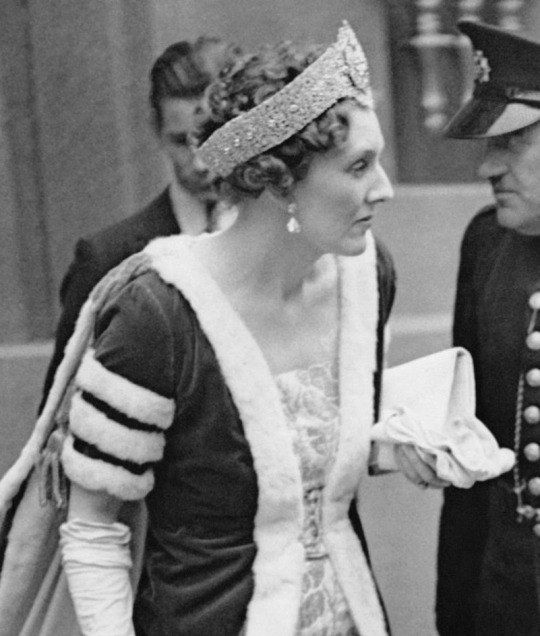
* Coronation Tiaras *
Mary 'Mollie' Montagu Douglas Scott, Duchess of Buccleuch & Queensberry, wore the Buccleuch Belt Tiara for the coronation of King George VI of the United Kingdom at Westminster Abbey on 12 May 1937
#Coronation Tiaras#Duchess of Buccleuch#tiara#United Kingdom#British Nobility#British Aristocracy#diamond
112 notes
·
View notes
Photo

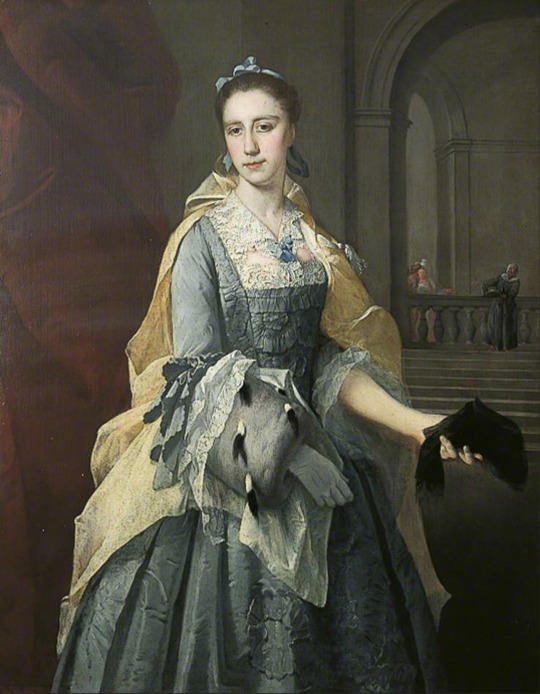



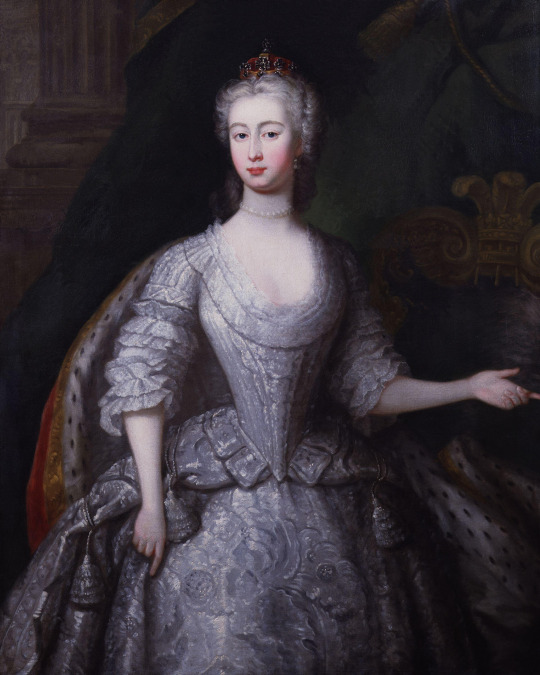
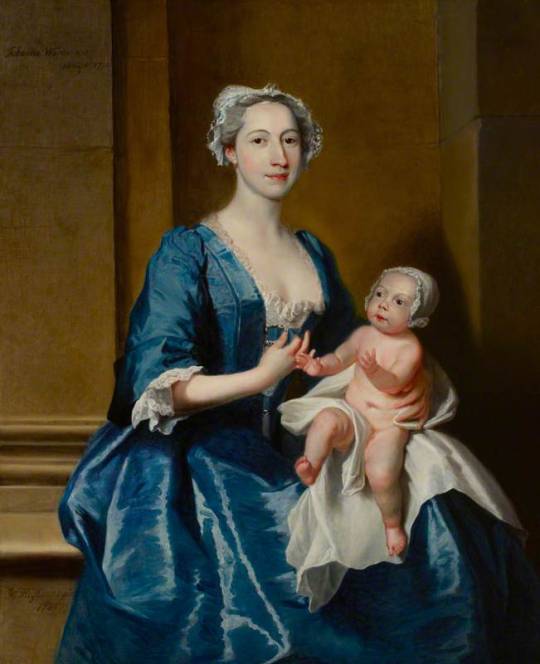
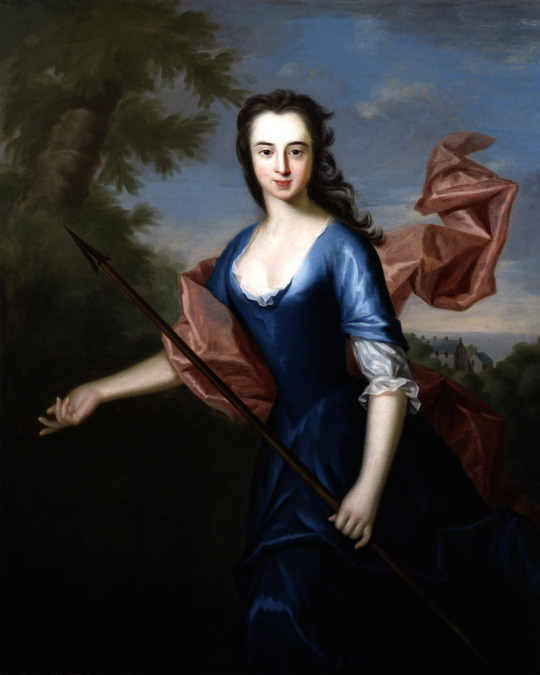
Further into the thirties (from top to bottom) -
The sleeves are usually elbow length and close, but not tightly squeezing, the arm and cuffed, An under-sleeve with a flared cuff emerges from the sleeve.1735 A Music Party by Marcellus Laroon (Birmingham Museums & Art Gallery - Birmingham, West Midlands, UK). From their Web site 1638X2246. No panniers here.
1735 Catherine Havers attributed to Barthélemy Du Pan (Temple Newsam House - Leeds, West Yorkshire, UK). From artuk.org 1414X1818. The dress could have been worn, minus the cuffs, until the 1770s.
1735 Catherine Hyde, Duchess of Queensberry, as a Dairy Maid, Marble Hill by Charles Jervas (Marble Hill House - Twickenham, London, UK). From artsandculture.google.com/entity/catherine-douglas-duchess-of-queensberry/m0gfdypy 1722X2138.
1735 Henrietta, née Godolphin, wife of Thomas Pelham-Holles, Duke of New Castle Upon Tyne and first Duke of Newcastle Under Tyne and Prime Minister by Charles Jervas (auctioned by Sotheby's) 920X1163.
1736 Anne, Princess Royal and Princess of Orange by Bernard Accama (location ?). From the lost gallery's photostream on flickr 1047X1539.
1736 Augusta of Saxe-Gotha-Altenburg, Princess of Wales by Charles Philips (National Portrait Gallery - London, UK). From www.liveinternet.ru/users/marylai/post292168318 2400X2998.
1736 Johanna, Mrs Robert Warner of Bedhampton, and Her Daughter, Kitty (d.1772), Later Mrs Jervoise Clarke Jervoise by Joseph Highmore (Mottisfont Abbey - Mottisfont, near Romsey, Hampshire, UK). From bbc.co (now artuk.org) 651X800.
1736 Katherine Hall of Dunglass by Allan Ramsay (private collection). From the Philip Mould Historical Portraits Image Library; fixed spots w Pshop 2418X3023.
#1730s fashion#Georgian fashion#Louis XV fashion#Rococo fashion#Marcellus Laroon#train#shoes#Catherine Havers#Barthélemy Du Pan#lace engageantes#fur muff#Catherine Hyde#Charles Jervas#U neckline#Henrietta Godolphin#V neckline#modesty piece#Princess Royal Anne#Bernard Accama#robiings#Princess of Wales Augusta#Charles Philips#court mantua#Johanna Warner#Joseph Highmore#cap#square neckline#Katherine Hall of Dunglass#Allan Ramsay#long hair
24 notes
·
View notes
Text
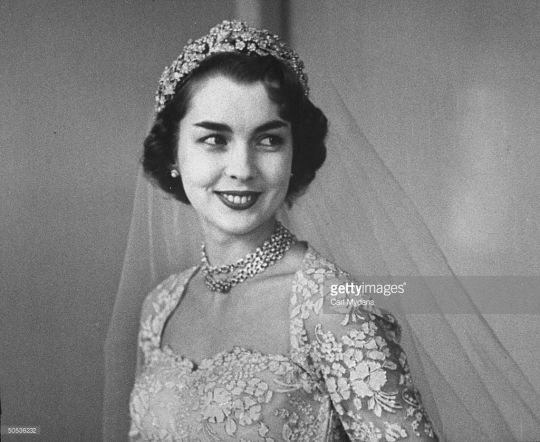
✵ January 10, 1953 ✵
Jane McNeill & Walter “John” Scott, Earl of Dalkeith
Later Duke and Duchess of Buccleuch and Queensberry
13 notes
·
View notes
Photo

The Most Noble Vreda Esther Mary Montagu Douglas Scott, “Molly”, Duchess of Buccleuch and Queensberry, wife of the 8th Duke of Buccleuch and 10th Duke of Queensberry, in the Great Hall, Boughton House, Northamptonshire.
31 notes
·
View notes
Photo





Jane Scott, Duchess of Buccleuch and Queensberry wedding dress
5 notes
·
View notes
Text
Attendees of King Charles III & Queen Camilla's Coronation
British Royal Family
The Prince of Wales
The Princess of Wales
Prince George of Wales *
Princess Charlotte of Wales
Prince Louis of Wales
The Duke of Sussex
The Duke of York
The Duke of Edinburgh
The Duchess of Edinburgh
The Princess Royal
Sir Vice Admiral Timothy Laurence
Princess Beatrice, Mrs. Mapple Mozzi
Mr. Eddo Mapple Mozzi
Princess Eugenie, Mrs. Brooksbank
Mr. Jack Brooksbank
The Earl of Wessex
The Lady Louise Mountbatten-Windsor
Mr. Peter Philips
Mrs. Michael Tindall
Mr. Michael Tindall
The 2nd Earl Snowdon
The Viscount Linley
The Lady Margarita Armstrong-Jones
The Lady Sarah Chatto
Mr. Daniel Chatto
Mr. Samuel Chatto
The Duke of Gloucester
The Duchess of Gloucester
The Duke of Kent
The Earl of Ulster
The Earl of St. Andrews
The Lady Davina Windsor
The Lady Rose Gilman
Lady Helen Taylor
Princess Alexandra, The Hon. Lady Ogilvy
Prince Michael of Kent
Princess Michael of Kent
Lord Frederick Windsor
Lady Gabriella Kingston
Mr. James Ogilvy
Ms. Marina Ogilvy
Penny, The Countess of Mountbatten of Burma
Mrs Sarah Troughton-Barclay**
Mr. Peter Barclay
Mr. Edward Tollemnache
Mrs. Sophie Tollemache
Master Ralph Tollemache**
Shand-Parker-Boweles Family
Mr. Tom Parker-Bowles
Mrs. Laura Lopes
Mr. Harry Lopes
Mr. Andrew Parker-Bowels
Miss Lola Parker Bowles**
Mr. Freddy Parker Bowles**
Miss Eliza Lopes**
Mister Louis Lopes**
Mister Gus Lopes**
Mrs. Anabelle Eliot
Mrs. Alice Irwin
Miss Ayesha Shand
Mr. Benjamin Eliot
Mrs. Catherine "Katie" Eliot
Master Arthur Eliot**
**Prince George of Wales, Lord Oliver cholmondeley, Master Nicholas Barclay, Master Ralph Tollemache, Mr Gus Lopes, Mr Louis Lopes, Mr. Freddy Parker-Bowles, Master Arthur Eliot will serve as Pages of Honour during the ceremony, while Queen Camilla's teenage grandchildren will participate in the ceremony in a different way as well.
NON ROYAL DUKES, Earls and Marquis (All of whom have some coronation role)
The Marquess of Anglesey
The Duke of Westminster
The Earl of Caledon
The Earl of Dundee
The Duke of Norfolk
The Earl of Erroll
The Earl of Crawford and Balcarres
Baroness (Helena) Kennedy of The Shaws
General Sir Patrick Sanders
The Duke of Wellington
The Rt. Reverend and Rt. Hon the Lord Chartres
Baroness (Elizabeth) Manningham-Buller
The Duke of Buccleuch and Queensberry
Baroness (Floella) Benjamin
Dame Elizabeth Anionwu
The Marquess of Cholmondeley
The Marchioness of Cholmondeley
Lord Oliver cholmondeley**
Master Nicholas Barclay**
Reigning Royalty
DENMARK
Crown Prince Fredrik
Crown Princess Mary
THE NETHERLANDS
The King of The Netherlands
Queen of The Netherlands
The Princess of Oranje* ( Precoronation reception only, Source: https://www.royal-house.nl/latest/news/2023/04/17/coronation-of-king-charles-iii-and-queen-camilla)
Princess Beatrix *(Precoronatination reception only, Source: https://www.royal-house.nl/latest/news/2023/04/17/coronation-of-king-charles-iii-and-queen-camilla)
NORWAY
The Crown Prince of Norway
The Crown Princess of Norway
Sweden
The King of Sweden
The Crown Princess of Sweden
MONACO
The Sovereign Prince of Monaco
The Princess Consort of Monaco
JAPAN
The Crown Prince of Japan
The Crown Princess of Japan
SPAIN
The King of Spain
The Queen of Spain
The King Emerettius
The Queen Emeritia
LEICHTENSTEIN
The Hereditary Prince of Liechtenstein
The Hereditary Princess of Lichtenstein
LUXEMBOURG
The Grand Duke of Luxembourg
The Grandduchess of Luxembourg
BAHRAIN
The Crown Prince of Bahrain
BRUNEI
The Sultan of Brunei
BELGIUM
The King of The Belgians
The Queen of Belgium
The Duchess of Brabant*
*reception only
JORDAN
The King of Jordan
The Queen of Jordan
BHUTAN
The King of Bhutan
The Queen of Bhutan
KUWAIT
The Crown Prince of Kuwait
LESOTHO
The King of Lestho
MALAYSIA
The King of Malaysia
The Queen of Malaysia
MOROCCO
The King of Morocco
OMAN
The Sultan of Oman
QATAR
The Emir of Qatar
TONGA
The King of Tonga
NON REIGNING ROYALS
GREECE
The Queen of Greece
The Crown Prince of Greece
The Crown Princess of Greece
GERMANY
The Hereditary Prince of Baden
BULGARIA
The King of Bulgaria
ROMANIA
The Custodian of The Crown of Romania
The Prince Consort of The Custodian of the Crown of Romania
YUGOSLAVIA
The Crown Prince of Yugoslavia
The Crown Princess of Yugoslavia
DUBAI
The Emir of Dubai
Other Dignitaries
USA
First Lady Dr. Jill Biden
Miss Finnegan Biden
1 note
·
View note
Text
“Women of quality did not simply plunge with abandon into the fashionable world. Instead, they walked a fine line between the imperatives of conspicuous display and the pervasive moral critique of such display. This balance depended on a notion of appropriate levels of consumption and fashion, a flexible concept that left room for different levels of spending or display in different circumstances, but which also carried strong moral overtones. Women could justify their choices on the grounds that they were appropriate for a given situation, but there was no single level of consumption appropriate for all women – even all elite women – at all times.
It was even possible for one woman to hold two contradictory views depending on her circumstances; it was common, for instance, to criticize the ubiquity of French fashions, yet the same women who complained about such fashions often avidly sought them out. This behavior should be taken not as hypocrisy but as a reflection of the widely varied connotations that appropriate consumption could bear, from lavish display to self-conscious unfashionability. The self-creation that fashion made possible – and that didactic authors so feared – provided a means for women to tailor their public display to particular audiences.
But because “appropriate” consumption varied in different circumstances, it was a tool for contesting as well as displaying status. This possibility became particularly marked during the early eighteenth century, when the court ceased to perform its traditional function of providing leadership in fashion trends. Without this traditional leadership, decisions about fashion devolved on to members of the Quality themselves. While there were unquestionably individual women who helped set particular trends, and while designs from France were in widespread demand, there was no single source for determining fashions in dress, much less for setting appropriate levels of consumption in other areas.
The center for all fashionable consumption in Britain was unquestionably London, with the London Season increasingly prominent in the lives of the British elite. Membership in the Quality was impossible without participation in metropolitan culture. This trend is visible in female correspondence, which frequently condemned unfashionable life away from London. In 1717 Lord Strafford’s sister remarked that she shared his wife’s reluctance to live permanently at his Yorkshire estate, for “A Lady must be a strange dragell tale creature” to enjoy such an isolated life.
The worst insult Lady Catherine Clarke could employ against the “Muscovite Ambassadress” was that “by the fantasticalness of her dress I did conclude she was a country lady who pretended to give a mode.” Even other major towns were not immune from criticism. As the Duchess of Queensberry wrote from Edinburgh in 1734, “I have not mett with any one in this Country who doth not Eate with a knif [sic]; & drink a Dish of tea . . . my girle & I have been at an assembly mighty happy she, & I much amused by the many very extradinary [sic] fashions.”
Two years later Henrietta Knight wrote to the Countess of Hertford, complaining about life in rural Hampshire in similar terms: First of all, know there is but one book in the house and that is the Farrier’s Guide; – there is but one picture, and that is a rose and crown stained upon the window. . . . The gentlemen are booted at 5 in the morning and remain so all day. . . . One of the ladies stays at home and looks after her family, the other does nothing at all, or rides a-shooting or setting; and I stay at home out of complaisance and am idle through necessity. …When I mentioned the having drawn the story of Antiochus in a fan (which story I was obliged to inform the company of), I was answered, “What! a married woman employ herself in drawing love stories?” Upon which I immediately changed the discourse to a pudding.
…When Lady Rawdon moved to Ireland after her marriage, she claimed to be remarkable there for her taste and fashion. Because her husband’s previous two wives had both died about the same time after getting married, she noted with some amusement that all of Irish society was now waiting for her to drop dead as well, especially since her artfulness in arranging her jewelry made her look quite wealthy. “The effect it had with the Irish girls,” she commented, “was that they were perpetually engaged with the ends of their fingers or the sticks of their fans calculating how many remaining months I had to reign, each one proposing herself for my successor.”
Their alleged reaction combined ignorance, rudeness, and raw greed. No native Irish woman could live up to the standards of wealth or fashion so effortlessly achieved by Lady Rawdon – or at least so she believed. Yet even women who so self-consciously identified with fashionable, cosmopolitan culture did not necessarily reject the values expressed in moralizing literature that attacked this culture. The concept of appropriate forms of fashion and consumption could be used by women of the beau monde to evaluate others and to justify their own decisions; moreover, the idea linked decisions in these areas not only to status but to morality.
Failure to conform to appropriate standards revealed a basic moral failure, while conformity indicated virtue. Recognizing such judgments enables us to avoid the oversimplification of Veblen’s theory of conspicuous consumption, without tying us to an equally rigid alternative. Competitive display was certainly an important factor in aristocratic women’s perceptions of fashion and consumption, and they had a strong investment in demonstrating their wealth and status through lavish purchases, but it was not their only consideration.
The presence of a widespread discourse condemning indiscriminate consumption and fashionability as trivial or even dangerous meant that women of quality often sought to portray themselves as embodiments of moderation. The language they chose reflected and shaped their decisions about consumption, as they dealt with their own income levels, their families’ status claims, and the very different circumstances presented by, say, a grand occasion at court or a day at a country retreat.
Just as no woman lived her life exclusively in one social situation, neither was there simply one way of understanding appropriate consumption. The conflicting pressures from competitive display and the moral critique of fashion meant that this was always a contested issue. Concern about French fashions in particular was visible in many aristocratic women’s writings. These women were at the center of the debate over luxury and nationalism that was so strong in eighteenth-century English society; as we have seen in Chapter 2, critics used nationalistic language to attack English women’s devotion to French fashions.
Yet fashionable society continued to visit France, and English women there often chose to adopt local dress. In 1737 the Countess of Coningsby informed her sister that she had spent a morning in Paris surrounded by local tradespeople, whom she employed to put her “exactly in the French fashion.” Others imitated French dress but criticized the French themselves. The Duchess of Montagu wrote to her husband from France that despite her efforts to make herself “as French as I could,” she could not bring herself to pack on the heavy makeup they wore, and she found their hairstyles ridiculous. Yet, she said, “in this manner they sit and talk all at a time, of the beauty of their dress; indeed, I believe they are the most ridiculous people in the world.”
French fashions were even more heavily criticized when they appeared in England. After visiting Tunbridge Wells in 1750, Lady Jane Coke noted that a woman who had been brought up in France was the current toast, although “she is entirely French, so much so in her behaviour that such an awkward Englishwoman as myself would think her rather odd than pleasing.” But there was no escape from French dominance. “As for fashions,” Lady Jane acknowledged at another time, “according to English custom we follow the French Ambassadress.”
…Nor did women of quality always indulge in indiscriminately lavish consumption, even when they might seem to have free rein. When the Countess of Hertford described her husband’s dress for a royal review of his local militia in 1722, she noted with equal pride that he looked spectacular and that the silver fringe on his waistcoat was recycled from his wedding waistcoat, “so fresh that it passed for new and was much better because it cost nothing.” Such recycling of clothing was common even among the nobility.
Mourning also frequently brought out women’s practical side. In 1712, Lady Strafford wrote to her husband that she had delayed getting new livery for her servants since she believed her brother-in-law was about to die of smallpox, which would require putting the staff into gray clothes. Faced with the need to wear mourning at court, Dorothy Dyves similarly sought the most efficient use of her available resources. She wrote to her aunt asking whether it would be appropriate “instead of buying a white tabby, having a white and gold for the Birthday, and after that day, take the coloured lining out and wear it for mourning, which I think will be very genteel and agreeable.”
Those fashions and diversions – such as hoop petticoats, gaming, and plays – that were considered particularly morally dubious were the most problematic. Mary Delany praised her sister for disliking large hoops, remarking of herself, “I keep within bounds, endeavouring to avoid all particularities of being too much in or out of fashion.” Although Lady Elizabeth Ramsden admitted that quadrille was a fashionable pastime, she felt uncomfortable about its moral implications. “I cant think it either a very useful or commendable way of spending one’s whole time as I find many do,” she wrote, insisting that she avoided it as much as possible. Yet, she concluded, “if one absolutely refuses it one must not expect ever to be let into any body’s house.”
In 1714 Countess Cowper recorded in her diary that she had refused to engage in high-stakes gambling at court, which they rallyd me for, but I told my Mistress [the Princess of Wales] I playd out of duty and not inclination & having 4 Children no body woud think ill of me if for their sakes I desir’d to save my money. When I did not do any thing that was mean dishonest or dishonourable to do it, for which she commended me, & said she thought the Principal duty of a Woman was to take care of her Children.
Two decades later, Lady Irwin also found herself fearful for both her “conduct and fortune,” when she was instructed to gamble as part of her duties as a Lady of the Bedchamber to the Princess of Wales – but she obeyed nonetheless. After Mary Delany went to see a performance of Colley Cibber’s sentimental comedy The Careless Husband, she strove to articulate a justification for her decision: “I should like to see a play once a month, as when well chosen I think they are a rational and pleasing entertainment even for old people who have health and spirits to go, and who frequent no other public places.”
Cibber’s play was hardly an example of the lewd theater attacked by most social critics, yet Mrs. Delany was uncomfortably aware that all plays could be seen as morally suspect. This ambiguity toward fashion, marked by a sense of the importance of appropriate levels of display and conformity to social norms rather than the simple glorification of ostentatious wealth, typified the attitudes of many women of quality toward all forms of fashion and consumption, and provided the discursive framework through which they presented themselves to a variety of audiences. It also formed the basis of their evaluation of others’ levels of consumption, and often served as a reference point for their approval (or disapproval) of an individual’s personal character.
Naturally, in many instances these women considered the display of wealth and finery as appropriate, particularly for rites of passage or public events such as births, funerals, and coronations. Lady Irwin wrote approvingly of a celebration given for the Prince’s birthday in January 1733, which featured “96 dishes; beans, peas, and all the rarities that could be thought on” – a reflection of the luxury of out-of-season produce. For her first appearance after her marriage, at a royal birthday, Lady Anne Strafford wore a set of diamond jewelry and a velvet gown heavily encrusted with diamonds and gold trim.
…The didactic writers’ distinction between outward fashion and inward virtue was thus rendered more complex, even among women who chose to use the moralists’ language. How a woman wore her clothes was as significant as the apparel itself. In 1713, Lady Dupplin admired her brother Lord Harley’s new bride at her first appearance at court: “there was a vast Court every body wished her joy & great staring at her you may be sure but she went through that fatigue with all the ease that could be & none could make a finer figure, her Clothes & lace extreamly fine & well Chose.””
- Ingrid H. Tague, “Consumption and Fashion.” in Women of Quality: Accepting and Contesting Ideals of Femininity in England, 1690-1760
4 notes
·
View notes
Photo

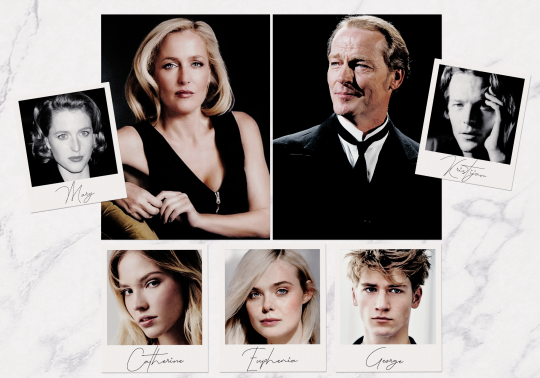

HSHQ TASK eleven —– FAMILY
the royal house of stuart
late king william iv & dowager queen anne
( donald sutherland & julie andrews )
grandpa william came onto the crown at age seven. his father passed away when he was merely five, and his grandfather succumbed from his wounds from the war just a few years later. a joint regency was established by his mother, the dowager princess charlotte, and his uncle: prince thomas. as soon as he reached majority age, he married his childhood sweetheart, lady anne egerton, third daughter to the earl and countess of morton. all things considered anne wasn’t important nor particularly special, but they fell in love, and the king had the luxury to marry whoever he wanted. king william had a lot to prove, which was why he was so deathly strict to all of his children, for they were a chance to prove his legacy. he had to prove that decades of regency would be worth it when he ascended the throne. when he passed, the dowager queen retained some of his trademark stuart rigidness towards her children, but spoiled her grandchildren immensely.
the late king and dowager queen had four children:
queen mary iii of scotland
princess isabel, the duchess of queensberry
prince james of scotland
prince robert, grand duke of greater bavaria
queen mary iii & prince consort christian
( gillian anderson & iain glen )
queen mary did not know the meaning of love. her love language is acts of service, and she truly believes that the best thing she could do for her family and people who were close to her, was to provide them with safety, riches, titles, and the like. conversely, people who did not provide her any service was treated as if they had gave her a personal slight. prince christian of poland was a respectable catholic match, especially for the ever so pious mary, and with one suggestion from the cardinal, she investigated the manner fully. kristijan, the youngest son of king stanisław had the easy confidence that mary was desperately lacking, but with the same sort of innate duty to his country. he’s perfectly content with standing one step behind his wife, to be less important with less responsibilities, he had many hobbies that occupied his time when he wasn’t pushing his nose into his children’s lives.
catherine, euphemia, & george
( sasha luss, elle fanning, danny griffin )
family dynamics task coming soon ig.
princess isabel & lord archibald douglas
duke and duchess of queensberry
( amy adams & ewan mcgregor )
and their children:
lord sebastian douglas, marquess of whithorn ( cameron monaghan )
lady amelia douglas ( annalise basso )
princess isabel is the society darling, president of the debutante board, patron to numerous finishing schools and various social clubs. uncle archie fell in love with her, hard, and did everything he could to win her hand. king william had approved of the marriage just because he would like more family control alongside the ever important southern border. sebastian has the same sort of passion as his father, having married at age twenty-four to his childhood sweetheart ( and debutante of the year ) lady rose murray, daughter of the duke of glasgow, a close family friend. mia, however, was determined to take her time, and make her own way in the world, despite the meddlesome way her mother had moulded her into becoming the next society darling.
prince james & princess eléanor
( simon baker & ashley judd )
and their children:
princess marie-adélaïde ( india eisley )
princess ava ( mackenzie foy )
prince edmund ( samuel joslin )
prince james, the wild-child, had met the utterly beautiful daughter of the duke of aiguillon and prince of turrene, princess eléanor de la tour d'auvergne and decided that all of the girls he dated before her had paled in comparison. she was the very image of french sophistication, and despite his higher rank, her air of lofty superiority had prompted deference even from him. they played the game for a while, chasing each other through the continent and making eyes across glittering ballrooms. that was until eléanor became pregnant unexpectedly with james’ baby, and both sets of parents decided that a marriage was necessary to avoid scandal. the young couple was hastily married, and marie-adélaïde came seven months later. they lived a slightly tumultuous existence, especially since they weren’t ready to get married and settle down in the first place. but with immense therapy and growing determination from both parties, they hadn’t given up yet. eight years after addie then came ava, and a year after that came edmund.
prince robert & lady wiebke wittelsbach
grand duke and duchess of greater bavaria
( kevin mckidd & angela sarafyan )
and their children:
lady anna-amalia wittelsbach of greater bavaria ( lauren de graaf )
lord mathias stuart of greater bavaria ( george mackay )
ya’ll know wibbie. they’re adorable. the stuarts can’t figure out just how robbie the absolute clown had gotten wiebke to take him seriously! a miracle tbh.
4 notes
·
View notes
Text
I found this on NewsBreak: Duchess of Buccleuch dies, aged 68, after short illness
I found this on NewsBreak: Duchess of Buccleuch dies, aged 68, after short illness
0 notes
Text

NAME: Adeline 'Addy' Gibson
PRONOUNS: She/Her
FACECLAIM: Sydney Sweeney
AGE: 300
SPECIES: Vampire
RANK: Princess
OCCUPATION: Co-Owner of The Crimson Stage
BIOGRAPHY:
Born in 1723 to endless wealth and luxury, Adeline Gibson was the only and most prized daughter of the Most Noble Marquess of Queensberry of Scotland. By the time she was thirteen, her father had already arranged the perfect marriage for her: she would be the wife of a British Duke of higher standing. All hopes were laid on Adeline for their family’s advancement and Adeline was soon shipped off to the Duchey to live with her groom-to-be’s family, learning the ways of English aristocracy and her future role as the Duchess.
Things seemed to be going well and the future Duchess spent five years with the family as they waited for her to be of more suitable age for marriage. No one would have expected that unhappiness between the couple brewed the moment their eyes met. The Duke was of much older age and had little use for a child–only agreeing to the marriage after seeing the fruits of Adeline’s parents’ marriage: six children, with only one daughter? What heir-deprived family wouldn’t wish for such a potentially high-yielding daughter-in-law?
Her future husband’s distaste and the reality of her value set into Adeline’s heart early on and she found herself desperate for an escape from such a miserable future. Youth and desperation were a dangerous combination and it wasn’t long before she found herself giving her heart away to the family’s youngest stable-boy. They would fill each other’s heads of dreams of running away, of a love so forbidden for people of Adeline’s standing. Such passion was soon consummated and the Duke’s family got exactly what they had asked for: a frighteningly fertile future daughter-in-law.
It was very obvious that the child was not the Honorable Duke’s child, after all, the marriage hadn’t even been officiated, let alone consummated, and Adeline was immediately shunned from the Duke’s family, sent back to Scotland in absolute disgrace. (She wasn’t even welcomed to stay long enough to know the fate of her lover.) Things were no better once Adeline was home. Her shame was written all over her body and the Marquess, who had once so adored his sweetest daughter, could not bear to look at her. With the heaviest of hearts the Marquess cast away his only daughter, shipping her off to a nunnery in hopes that a lifetime of service to the Lord would be enough to wash away her sin.
Life for Adeline at the nunnery was not any easier. She saw the way the women looked at her, the disgust in their eyes, the fear for her fate upon judgement day, and the truth that they only agreed to take care of her and hide her away due to a generous donation made by her father. In fact, she didn’t need to see them to know all of that: they voiced their opinions loud and proud–Adeline was a sinner of the worst kind and they would pray that the little child inside her belly would not be tainted with such sin throughout his own life.
With no other voice to guide her, she internalised the nuns’, realising that she could never give her unborn child any life worth living so long as her disgrace followed him. She didn’t even get a chance to hold him after she made the decision to give him up–the nuns whisked him away the moment he cried and all Adeline could do was beg and pray that they would give him the letter she wrote him. With the child born, Adeline had no reason to stay in the cage of the nunnery and went off on her own.
As a former noble lady, Adeline had few skills to sell. The only thing that appealed to men around her was her body and since it was already so steeped in sin, Adeline couldn’t find reason to object. She sold her body for what little pittances they were willing to spare and gained enough popularity that the local brothel mistress of a small port town agreed to take her in. It wouldn’t be much better, but it was a roof over her head and the protection of girls like her.
Adeline, now going by ‘Mary’, continued to work at the brothel, wooing sailors with her beautiful voice. The men would fall at her feet, some going so far as to call the enchantress a siren. Adeline wore the title with pride, singing her songs and finding her place amongst the women who had been scorned by the world around them. Still, Adeline was never content. She dreamed of adventure and the sailors she spent nights with would fill her head with stories of what lay beyond the port. Some even made promises to take her with them, only to leave her bed empty the next day. Without shame, they would return a few months later, expecting the same treatment they received before.
Adeline had survived this life for four years when someone new stepped into the brothel. Unlike the dirty sailors she often catered to, this woman was angelic. She quietly took a seat in the corner of the room and simply watched, as if unaware of the sinful establishment she had stepped into. The entire time, as Adeline performed her songs, the woman never once tore her eyes away from her and it was a look that Adeline would never forget–one that forever changed her life.
Faith would spend nights with Adeline, telling her all about her own travels, and Adeline was immediately enchanted by the strong woman, able to live her dreams with no man by her side. Despite her better judgement, Faith trusted Adeline with the truth and Adeline trusted Faith with her story. Within a few days Adeline was begging for Faith to save her, to give her the same life she enjoyed. Faith had never turned anyone before but with Anna’s approval and supervision, Adeline’s new life began.
Adeline continued to train under Faith, the two of them following Anna loyally as their travels continued. Once Adeline had matured enough as a vampire and with their mother’s blessings, Faith and Adeline struck out on their own, living the life Anna had gifted them with to the fullest. They rampaged around the New World, enjoying their freedom with their mother’s approval. The two vampires were absolute menaces and nothing could stop them. It wasn’t until Anna decided to make a home in New York did the girls settle down. They helped Anna build her empire, dutifully, and destructively, along with their other siblings, and earned the life they have now.
1 note
·
View note
Photo
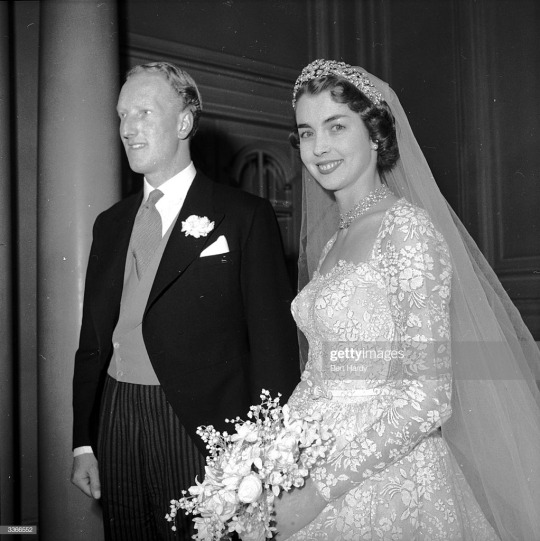
Buccleuch Mayflower Tiara ♕ Richard Scott, 10th Duke of Buccleuch and 12th Duke of Queensberry
#buccleuch mayflower tiara#mayflower tiara#flower tiara#flower jewelry#floral tiara#floral jewelry#aristocrat#British aristocrat#aristocrat diamond tiara#aristocrat diamond jewelry#aristocrat tiara#scottish aristocrat#scottish aristocracy#wedding tiara#Wedding Jewelry#duke of buccleuch#duchess of buccleuch#duke of queensberry#duchess of queensberry#richard scott#Aristocracy#british aristocracy#Diamond Jewelry#diamond jewels
59 notes
·
View notes
Text
The Rules of Bath
The Rules of Bath
Richard ‘Beau’ Nash, dandy, Bath’s Master of Ceremonies and unofficial ‘king’ of the city was born in 1674. He set the rules by which Bath society regulated their days, and established it as a resort of fashion. You had to pass Beau Nash’s scrutiny just to be granted admission to the balls and card parties and even the highest in the land had to do as he said.

Richard Beau Nash (1674-1761) by…
View On WordPress
#Assembly Rooms#Bath#Beau Nash#country dances#Duchess of Queensberry#Fashion History#minuet#Pump Room#The Rules of Bath#William Wade
0 notes
Photo
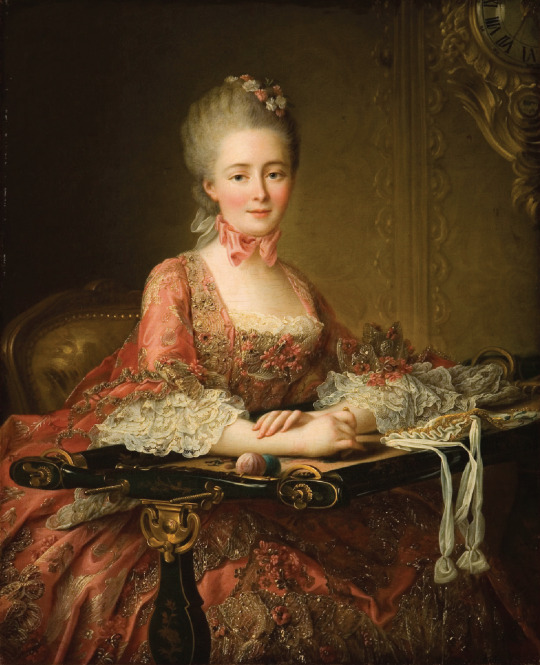


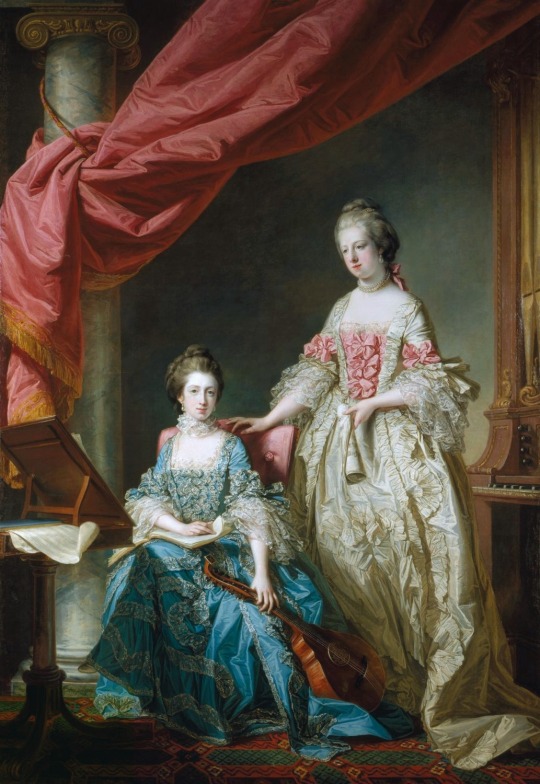
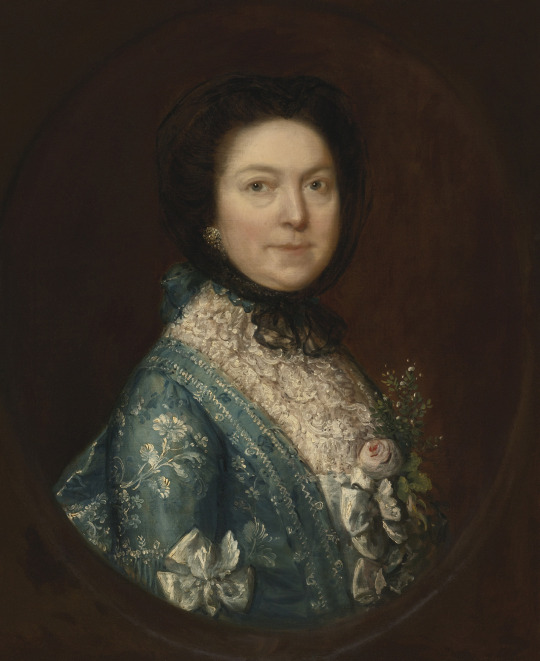
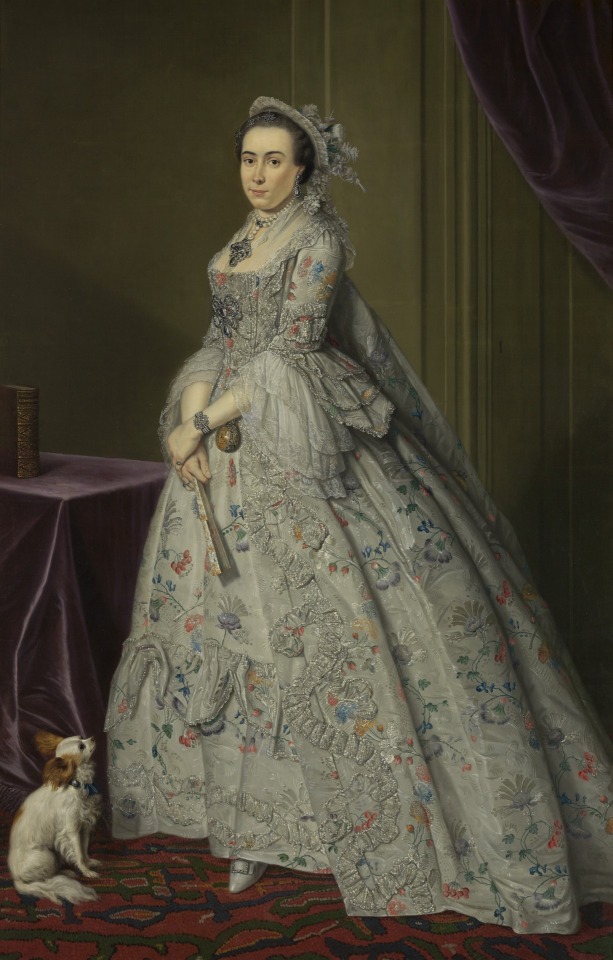
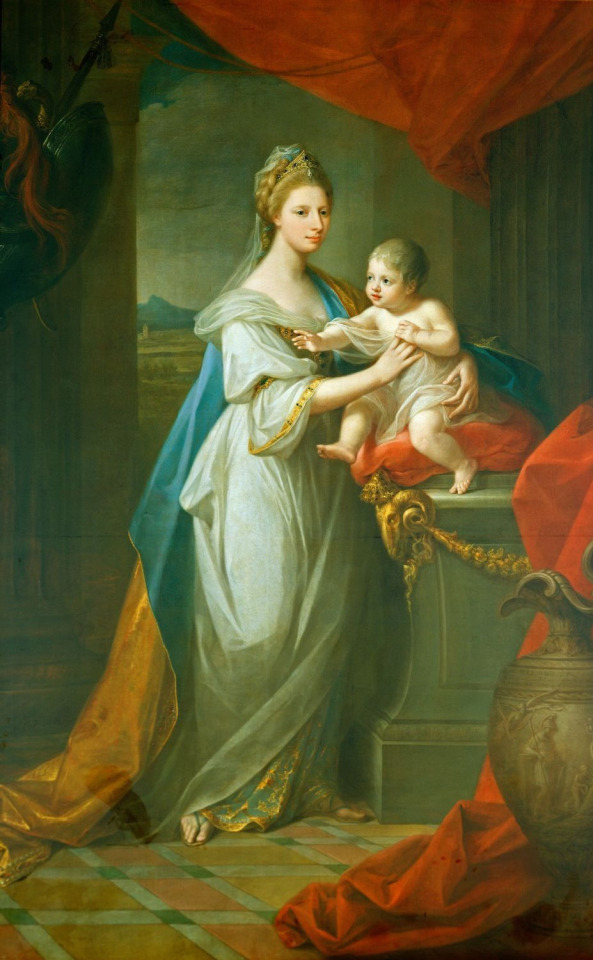



It’s now 1767 -
Top: 1767 Marquise de Caumont La Force by François Hubert Drouais (Ball State University - Muncie, Indiana, USA). From their Web site 1466X1806 @72 3.1Mp.
Second row left: ca. 1767 Lady Elizabeth Montagu, Duchess of Buccleuch and Queensberry by Thomas Gainsborough (Boughton House - GeddNorthamptonshire, UK). From cutlermiles.com/portrait-of-lady-elizabeth-montagu-duchess-of-buccleuch-and-queensberry-thomas-gainsborough/. 1440X1764 @144 2.6Mp.
Second row right: 1767 Lady Mary Fox wearing a Brunswick by Pompeo Batoni (location ?). From Wikimedia; fixed spots & flaws w Pshop 722X1010 @150 672kj.
Third row: 1767 Princess Louisa and Princess Caroline by Francis Cotes (Royal Collection). From Wikimedia 1033X1500 @28pixels/cm 407kj.
Fourth row left: ca. 1767 Lady Alston wearing a robe à la française by Thomas Gainsborough (auctioned by Sotheby's). From Wikimedia; fixed spots and flaws with Photoshop 1633X2000 @180 1.2Mj.
Fourth row right: 1767 Cecilia de Clercq by Tibout Regters (location ?). From liveinternet.ru/users/4853296/post435796664/ 1225X1920 @72 594kj.
Fifth row: 1767 Augusta Friederike Hannover by Angelica Kauffman (Royal Collection). From Wikimedia 927X1500 @72 370kj.
Sixth row left: 1767 Princess Louisa of Great Britain (Royal Collection). From Wikimedia; removed linear flaws with Photoshop 1240X1500 @198 623kj.
Sixth row right: ca. 1767 Izabela Lubomirska by Per Krafft the Elder after Alexander Roslin (Pałac Na Wyspie - Warszawa, Poland). From Wikimedia 1564X1970 @96 790kj.
Seventh row: 1767 Archduchess Maria Josefa by Anton Rafael Mengs (Museo Nacional del Prado - Madrid, Spain). From liveinternet.ru/users/marylai/post292168318 2004X2709 @300 2.1Mj.
#1767 fashion#Louis XV fashion#Georgian fashion#Rococo fashion#Marquise de Caumont La Force#François-Hubert Drouais#Elizabeth Montagu#Thomas Gainsborough#Mary Fox#Pompeo Batoni#brunswick garment#Princess Louisa#Princess Caroline#Francis Cotes#Lady Alston#robe à la française#Cecilia de Clercq#Tibout Regters#Augusta Friederike Hannover#Angelica Kauffman#British casual#Izabela Lubomirska#Per Krafft the Elder#Alexander Roslin#Archduchess Maria Josefa#Anton Rafael Mengs
19 notes
·
View notes
Photo

✵ January 10, 1953 ✵
Jane McNeill & Walter “John” Scott, Earl of Dalkeith
Later Duke and Duchess of Buccleuch and Queensberry
35 notes
·
View notes